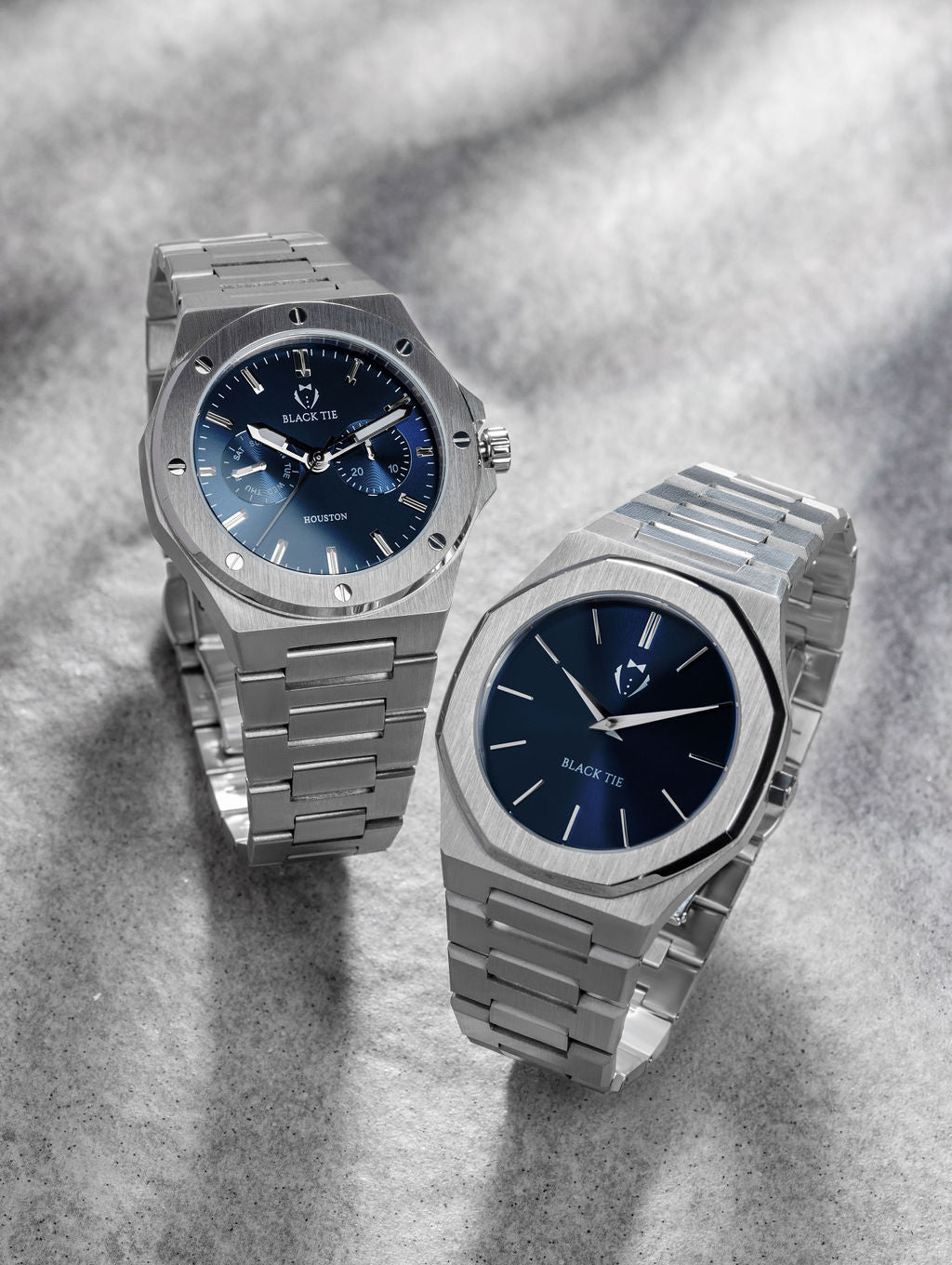Whether you're a seasoned collector or a first-time buyer, this comprehensive guide will equip you with the knowledge you need to make an informed decision. So, let's dive in and discover your perfect timepiece!
Define Your Style:

Before diving into technical details, it's crucial to identify your personal style and the purpose of your watch. Consider the occasions you'll be wearing it for and the overall aesthetic you prefer. Are you looking for a classic dress watch, a rugged sports watch, or a versatile everyday timepiece? The answer to this question will guide your decision-making process. Pay attention to factors such as case size, dial design, color schemes, and strap materials to align with your preferences and lifestyle.
Movement Matters:
The movement is the heart of any watch, determining its accuracy and functionality. There are three primary types of watch movements to consider:

Onyx - Blue (Quartz Movement)
Quartz Movement: Known for its affordability and accuracy, quartz watches are powered by a battery and require minimal maintenance. They offer reliable timekeeping and are often the go-to choice for everyday wear. Quartz watches have a distinct ticking motion of the seconds hand.

Spyder - Steel (Automatic Movement)
Automatic Movement: Automatic watches are self-winding and powered by the natural motion of the wearer's wrist. As you wear the watch, a rotor inside the timepiece rotates, transferring energy to the mainspring and keeping it wound. They offer a blend of traditional craftsmanship and convenience. Automatic watches usually have a sweeping motion of the seconds hand.
Mechanical Movement: Highly regarded for their intricate craftsmanship, mechanical watches are manually wound and require regular winding to keep them running. These watches are a testament to the art of watchmaking, with complex mechanisms and precise engineering. Mechanical watches also have a sweeping motion of the seconds hand.
Consider your preferences regarding maintenance, accuracy, and the experience of owning a mechanical watch when deciding which movement type suits you best.
Material Selection:
The choice of materials impacts both the aesthetics and durability of your timepiece. Common materials used for watch cases and bracelets include stainless steel, titanium, ceramic, and precious metals like gold or platinum. Stainless steel offers a balance between durability, affordability, and versatility, making it a popular choice for many watch enthusiasts. Titanium is known for its lightweight and hypoallergenic properties, making it an excellent option for those with sensitive skin. Ceramic provides a sleek and scratch-resistant option, while precious metals offer a touch of luxury and prestige. Consider factors like scratch resistance, weight, corrosion resistance, and overall appearance to find a material that suits your style and needs.
Complications and Features:
Complications refer to additional features beyond the basic timekeeping function. These can include chronographs, moon phases, calendar displays, power reserve indicators, and more. Determine which complications are important to you and add value to your watch. Keep in mind that more complications may increase the complexity and cost of the timepiece. If you have specific needs or interests, such as diving or aviation, there are watches designed with specific complications tailored to those activities. Consider whether you prefer a minimalist, clean dial or a more intricate design with multiple complications.
Brand Reputation and Heritage:
Researching the reputation and heritage of watch brands before making a purchase is crucial. Established brands with a rich history often have a legacy of quality and craftsmanship. Look for brands known for their attention to detail, innovation, and reliability. Explore their brand values, customer reviews, and after-sales service to ensure a satisfying ownership experience. Some brands may have particular expertise in certain types of watches, such as diving watches or pilot watches, so consider brands that align with your interests and requirements.
Budget Considerations:
Set a budget range that aligns with your expectations and explore watches within that range. It's important to remember that while high-end luxury watches offer exceptional quality and prestige, there are also great options available at more affordable price points. Determine your priorities and strike a balance between quality, features, and budget. Researching different brands and models will give you an idea of the price range for watches with the specifications you desire. It's worth considering that well-made watches can be viewed as investments, as they often retain their value and can even appreciate over time.
Try Before You Buy:
Whenever possible, try on the watch before making a purchase. Visit authorized retailers or watch boutiques to see the timepiece in person. Pay attention to how it feels on your wrist, the weight, and the overall comfort. This firsthand experience will help you make an informed decision and ensure the watch suits your personal taste and comfort. If trying it in person is not feasible, explore online platforms that provide detailed product images and specifications. Read customer reviews to gain insights into how the watch wears and feels on the wrist.




Leave a comment
This site is protected by hCaptcha and the hCaptcha Privacy Policy and Terms of Service apply.